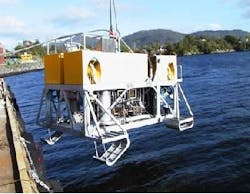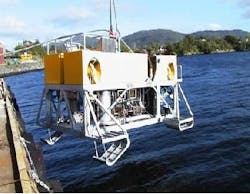ROV/trencher capable of 14 days' uninterrupted service at 3,000 meters
Nordic Offshore is a new company targeting the market for subsea trenching of cables and pipelines with a novel, remotely-operated underwater vehicle, ROTS II. The design of the machine is based on the experience of Nordic's two parent companies, Swedia Networks and Dyk & Sjotjanst i Uddevalla, both of which have been active in the marine trenching business using ROVs for several years. Their background is predominantly in small diameter cables; however, they are confident of making the transition into the larger diameter pipeline business with the new vehicle.
Key features of ROTS II are its ability to operate in water depths up to 3,000 meters and to run continuously for up to 14 days at high speed without the need for surfacing. Nordic claims no other company in the world can offer this capability. Gosta Nilsson, Nordic Offshore's technical manager, explained that the parent companies had been working with a first generation vehicle, ROTS I, since 1996. This has been used to trench over 85,000 km of cable in the North Sea and the Baltic, including buried cables for the Heidrun and Sleipner fields. ROTS II is a larger, much more powerful and highly developed variant.
Fluidized bed
The machine uses jetting nozzles fed by high volume water pumps to fluidize the seabed and then shift the fluidized material from the trench. The company has a patent on a highly adjustable "jetting sword," which can be raised and lowered into the seabed, the process being controlled from the surface. The desired trench depth is achieved by altering the angle and depth to which the sword penetrates the soil. The ease with which the sword can be controlled means that the trenching operation can be constantly optimized for changing seabed conditions. Nilsson considers the ability to control the jetting sword accurately without the need to bring the vehicle back to the surface as one of the vehicle's greatest advantages over commonly-used mechanical trenching machines.
The vehicle will typically employ two jetting swords running on each side of the cable or pipe. It may also carry high pressure nozzles at the front and rear to aid fluidization and transport of the seabed material backwards. This would certainly be the case for wider, deeper channels.
Nilsson says the vehicle will trench in sand, silt, and clay, and will not cause damage to the cable or pipeline. It is also very easy to launch and retrieve, without the need for an A-frame or specialist handling equipment. Thrusters are used to propel the vehicle in "free flight" to the seabed, to position it over the cable or pipe, and then to drive it along in tandem with the jetting swords. The company has found that backfilling of the trench generally occurs naturally; this can be to a level of 25-90%, depending on the soil conditions and the strength of the seabed currents.
The ROTS II vehicle weighs just over 12 tons and is approximately 5 meters long, 4 meters wide, and 3 meters high. It has 200 kW of hydraulic power, driving eight thrusters. In addition, it carries single wheel, centrifugal water pumps for trenching, which are rated at 550 kW, specially designed for this heavy duty continuous operation. The vehicle is also equipped with navigational aides, sensors, sonar equipment, and cameras, which give it the same maneuvering, surveillance, and communications capabilities as most working ROVs.
Trenches up to 2.5 meters deep and 1 meter wide can be created at a speed of up to 15 meters/min, depending on the shear strength of the seabed material. It is therefore capable of trenching 1 meter diameter pipes.
16-in. flowline trials
Nordic's latest machine has undergone over 250 hours of testing on the seabed and is already being used to trench 220 km of telecommunications cable in the Baltic Sea. It has yet to be used commercially for trenching oil and gas pipelines of any diameter. However, discussions are taking place with Norsk Hydro and Statoil in regard to carrying out trials with the intention of trenching 16-in. flowlines.
Though rated to operate at depths of up to 3,000 meters, the current vehicle has not gone beyond 1,000 meters. "We do not see this as an issue," says Nilsson. "The onboard systems were chosen or designed for their ability to operate at 3,000 meters. The only change we will need to make to the vehicle to go this deep is a longer umbilical."
Although ROTS II has yet to really prove itself, Nordic is also talking about using the ROV for carrying out deburial and repair of pipelines on the seabed. It is also giving serious thought to an even more powerful and efficient machine.
For more information, contact Gosta Nilsson, Nordic Offshore. Tel: +46 522 813 79, Fax: +46 522 151 60, E-mail [email protected]

